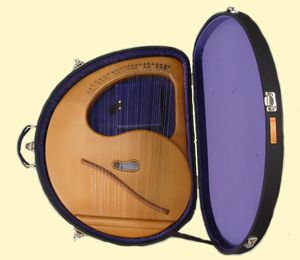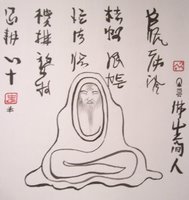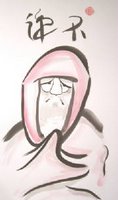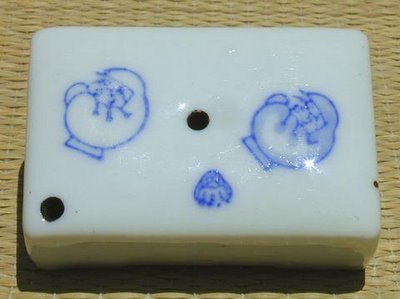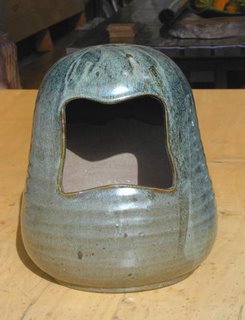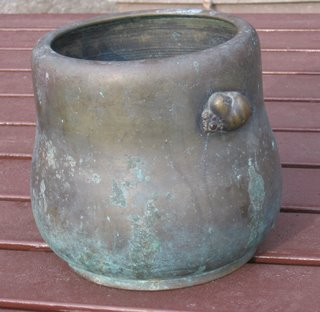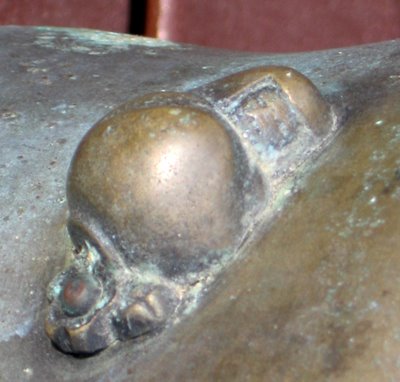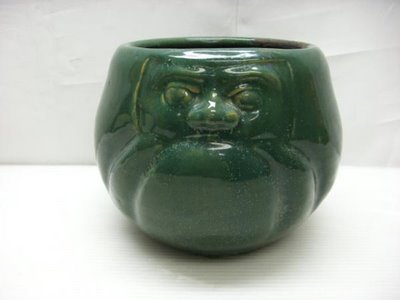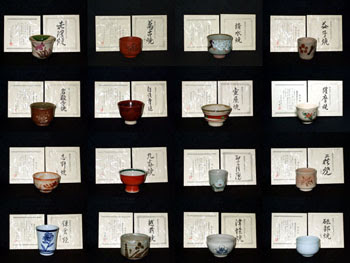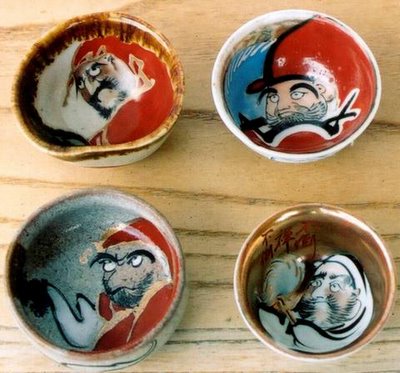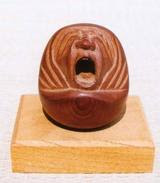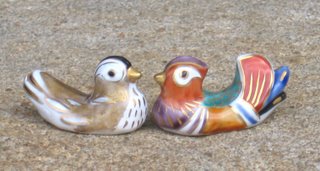:::::::::::::::::::::::::::::::::::::::::::::::::::::::::::::::::::::::::::::::::::::::::::::::::::::
.. .. .. .. Haiku and Daruma san
I am trying to combine my two hobbies, Daruma and Haiku.

Daruma San -
high in the sky
a firework dances
:::::::::::::::::::::::::::::::::::::::::::::::::::::::::::::::::::::::::::::::::::::::::::::::::::::
. Daruma Memorial Day 達磨忌 Daruma-ki
and more KIGO with Daruma
.................................................................................
We have some guidelines about the keyword DARUMA and related items, which are listed at the end of this page.
Daruma jumps
to new hights -
this leap day

February 29, 2012
:::::::::::::::::::::::::::::::::::::::::::::::::::::::::::::::::::::::::::::::::::::::::::::::::::::
Here are some of the best of the above collections.
Some of Chibi's Contributions
Koinobori, Carp Streamers
http://worldkigodatabase.blogspot.com/2005/03/carp-streamers-koinobori.html
Daruma wobbles --
streamers flap
in the May breeze
Koinobori
for the home of
Daruma
Daruma wobbles --
streamers flap
in the May breeze
Daruma doll
bows and bows
and bows
ear pick --
Daruma squints
one eye
Easter egg plant --
Daruma wears a green
hat
:::::::::::::::::::::::::::::::::::::::::::::::::::::::::::::::::::::::::::::::::::::::::::::::::::::
rainy season --
Daruma's beard
becomes thick
gardenia –
the lingering smell of
Daruma's stroll ... Chibi
kuchinashi ya
Daruma talks
you have no mouth ... Gabi
http://www010.upp.so-net.ne.jp/pha/flo0307kuchinasi.htm
Gardenia in Japanese is Kuchinashi, literally: to have no mouth.
:::::::::::::::::::::::::::::::::::::::::::::::::::::::::::::::::::::::::::::::::::::::::::::::::::::
Daruma-sama..........だるまさま
kyoo mo ashita mo.......今日も明日も
Daruma-sama..........だるまさま
Daruma sama
Today and tomorrow
Daruma sama
Gabi
:::::::::::::::::::::::::::::::::::::::::::::::::::::::::::::::::::::::::::::::::::::::::::::::::::::
.. .. .. just one stroke
.. .. .. just three lines
.. .. .. just one life
IPPITSU and ENSOO - One Stroke, One Circle
:::::::::::::::::::::::::::::::::::::::::::::::::::::::::::::::::::::::::::::::::::::::::::::::::::::
Matsushima ya suterareta Daruma mo shiawase ja
AAA, Matsushima
even thrown-away Daruma
must be happy!
Gabi
Daruma in Matsushima

:::::::::::::::::::::::::::::::::::::::::::::::::::::::::::::::::::::::::::::::::::::::::::::::::::::
sitting in silence
Daruma meditating
in Japanese

Gabi (this has become my profile foto ! )
......................................................................................................................
spring wind -
Daruma sits
limbless
Chibi
> >>>> Daruma san
>>>>> takes a pause
>>>>> in space and time
Gabi
:::::::::::::::::::::::::::::::::::::::::::::::::::::::::::::::::::::::::::::::::::::::::::::::::::::
shooting stars*:
Daruma recites sutra
after surta!
.. .. .. stars in my eyes
.. .. .. I re-sight the sutra
.. .. .. that I had forgotten
ai... chibi
*The Geminids peaked last night about midnight, USA EST. My sons saw two bolides (fireballs or bright long trailed meteors). I counted four meteors, total, but only was able to see one bolide.
Read more about Haiku and the Leonid Meteor Shower:
http://worldkigodatabase.blogspot.com/2005/12/leonid-meteor-shower.html
:::::::::::::::::::::::::::::::::::::::::::::::::::::::::::::::::::::::::::::::::::::::::::::::::::::
snow pellets
on winter coats:
Daruma's eyebrows
chibi
http://groups.yahoo.com/group/Darumasan-Japan/message/633
:::::::::::::::::::::::::::::::::::::::::::::::::::::::::::::::::::::::::::::::::::::::::::::::::::::
New Year comes!
Daruma's worn sandals
replaced
Chibi
Take a look at Daruma's pilgrim sandals replaced here at the temple gate of Saikoku-Ji

:::::::::::::::::::::::::::::::::::::::::::::::::::::::::::::::::::::::::::::::::::::::::::::::::::::
Happy Valentine!
RED robes and cheeks from
Daruma sama
chibi

:::::::::::::::::::::::::::::::::::::::::::::::::::::::::::::::::::::::::::::::::::::::::::::::::::::

春の日や達磨大師も尻悶
haru no hi ya Daruma Daishi mo shiri modae
fine spring day -
even Daruma Daishi
is getting restless
Tr. Gabi Greve
Choowa 調和, 読売新聞・四季
:::::::::::::::::::::::::::::::::::::::::::::::::::::::::::::::::::::::::::::::::::::::::::::::::::::
.. .. .. .. .. Daruma Haiku Guidelines
Haiku about Daruma san shall have DARUMA as a non-seasonal topic (haigon, KIGO-like keyword).
They can be serious or humorous, since many depictions of Daruma are in both ways.
I have an “Old People’s Home” Gallery in the museum for the many statues where Daruma is shown in a great variety of positions, from dead serious to outrageously funny, sometimes even with a charming lady at this side, but that is a story in itself.
Haigon pointing to Daruma
(the iconography of Daruma, to be scientific)
.. red robe
.. large eyes
.. one eye (me-ire)
.. circle (ensoo)
.. huge earrings (mimikazari)
.. KATSU!
.. one sandal (sekiri)
.. stone wall (menpeki kunen)
.. on a stone (ishi no ue san nen)
.. yawning (akubi)
This list can grow as we come up with more powerful words pointing to our Daruma san and the ZEN lore, if they inspire you to write a haiku about it. Feel free to add your words to this list.
As for now, check the following basic stories of the Daruma Homepage to learn more about the many symbols and stories connected to Daruma san in Japanese culture.
* * * * * * * * *
Basic Introduction
http://darumamuseum.blogspot.com/2007/01/who-is-daruma.html
About the eyes, Painting eyes
Me-ire - Painting Eyes for Daruma 達磨の目入れ
Daruma and his EYES
Earrings and Circle, Ensoo
http://darumamuseum.blogspot.com/2008/07/earrings.html
One Sandal, Sekiri Daruma
http://darumamuseum.blogspot.com/2007/02/sekiri-one-sandal.html
Stone wall (and yawning) menpeki to akubi, on a stone
http://darumasan.blogspot.com/2004/11/akubi-daruma-yawning.html
Sake and Daruma
http://darumasan.blogspot.com/2006/12/sake-and-daruma.html
KATSU!
http://darumasan.blogspot.com/
And a Gallery of Nature Pictures
reminding us of Daruma features.
photo album FLICKR
Have fun with your Daruma Haiku!
And add your contributions here as a comment.
Gabi Greve
December 2004
:::::::::::::::::::::::::::::::::::::::::::::::::::::::::::::::::::::::::::::::::::::::::::::::::::::
. Daruma Memorial Day 達磨忌 Daruma-ki
and more KIGO with Daruma
[ . BACK to WORLDKIGO TOP . ]
[ . BACK to DARUMA MUSEUM TOP . ]
:::::::::::::::::::::::::::::::::::::::::::::::::::::::::::::::::::::::::::::::::::::::::::::::::::::
